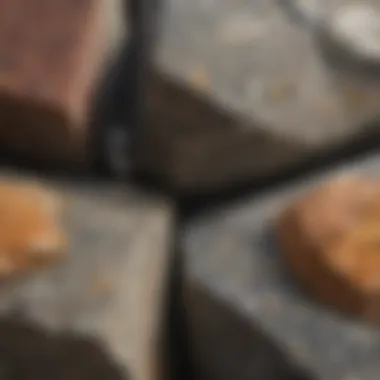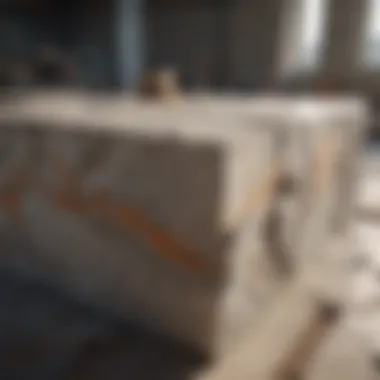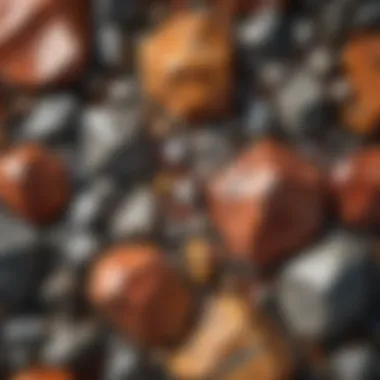An In-Depth Exploration of Granite's Appearance


Intro
Granite is one of the most sought-after materials in the world. Its striking appearance and remarkable properties make it ideal for both art and construction. Understanding granite requires a closer look at its unique features, from its color variations to its mineral composition. With a rich history and significant applications, granite captures the interest of collectors and professionals alike.
Granite is categorized as an igneous rock, formed from the slow crystallization of magma beneath the Earth's surface. This process allows for the development of large crystals that give granite its distinct texture and appearance. Essential elements in granite include quartz, feldspar, and mica, contributing to its durability and visual appeal. Whether you are a collector or a professional in geology, an in-depth exploration of granite will enhance your appreciation for this extraordinary stone.
Rock and Fossil Identification
Types of Rocks and Fossils
Granite, while primarily categorized as an igneous rock, is often discussed alongside other types of rocks such as sedimentary and metamorphic. Each category carries unique properties and formation processes:
- Igneous Rocks: Formed through the cooling and solidification of magma. Examples include granite and basalt.
- Sedimentary Rocks: Created from the accumulation of sediment. Examples include limestone and sandstone.
- Metamorphic Rocks: Formed from existing rocks under heat and pressure. Examples include schist and gneiss.
When identifying fossils, look for impressions or remnants of past life within sedimentary rocks. Common fossil types include tracks, shells, and even preserved organic materials.
Characteristics to Look For
Identifying granite requires a keen eye for specific characteristics. Notable features include:
- Color Variations: Granite appears in various colors, influenced by its mineral composition. Expect shades of gray, pink, and white, among others.
- Grain Texture: The visible crystals can vary in size, giving the rock a coarse or fine texture. This is essential for distinguishing granite from similar rocks.
- Dull vs. Shiny Surfaces: The finish of granite can vary, from polished to honed, impacting its aesthetic appeal.
Tools for Identification
Utilizing proper tools can facilitate rock identification:
- Hand Lens: Helps magnify mineral grains and textures.
- Rock Hammer: Useful for splitting rocks to observe internal structures.
- Field Guide: Having a reference book can assist in identifying various rocks and fossils.
Collecting Tips and Techniques
Best Practices for Collecting
When collecting granite or fossils, adhering to guidelines ensures both safety and preservation:
- Get Permission: Always seek permission before collecting on private or protected land.
- Leave No Trace: Minimize your impact on collecting sites.
- Document Finds: Take notes on location and conditions of your finds for future reference.
Locating Prime Collecting Sites
Researching areas with rich geological history is key. Look for:
- Quarries or Road Cuts: These often expose different rock layers, including granite.
- National Parks: Many parks have significant geological formations, offering opportunities for observation.
- Local Museums: They usually provide resources or tips on nearby sites.
How to Safely Extract Specimens
Extracting granite requires caution:
- Use Proper Tools: Ensure you have the right tools for minimal damage.
- Stabilize the Rock: If the rock is large, use wedges or shims.
- Wear Protective Gear: Safety glasses and gloves protect against injury.
Preservation and Display
Techniques for Preserving Rocks and Fossils
Once collected, preserving granite and fossils is essential:
- Keep Dry: Moisture can deteriorate fossils; dry storage is key.
- Display Cases: Use airtight cases to protect from dust and humidity.
Proper Storage Methods
Store granite specimens in stable conditions:
- Climate Control: Keep in environments with consistent temperature and humidity.
- Avoid Direct Sunlight: Prolonged exposure can lead to fading and damage.
Creative Display Ideas
Showcasing your granite collection can be innovative:
- Shadow Boxes: These create depth and protect specimens.
- Wall Mounts: Displaying rocks on walls can make a stunning visual impact.
Geological Insights
Geological Formations and Processes
Understanding granite begins with its geological formation. It forms from the cooling of magma over thousands of years, resulting in distinct crystalline structures. Various geological processes, including tectonic shifts and erosion, shape granite formations around the world.


Historical Significance of Rocks and Fossils
Granite has played a pivotal role in human history. Many historical structures, like the Great Pyramid of Giza, use granite, emphasizing its durability and prominence in ancient architecture.
Notable Discoveries in the Field
Significant findings of granite deposits in various regions have influenced art and architecture. From famous statues to expansive countertops, the allure of granite is evident across domains.
"Granite is not just a rock; it embodies millions of years of geological history, serving as both a canvas for artists and a backbone for buildings." - Geology Expert
Exploring granite allows us to appreciate its unique traits and its functions in our environment.
Understanding Granite
Granite is a widely recognized igneous rock, significant in both geological studies and practical applications. Understanding granite is essential for rock and fossil collectors, construction professionals, and anyone interested in geology. This section will explore the definition, formation process, and overall importance of granite.
Granite's unique characteristics – including its durability, aesthetic appeal, and its diverse color range – make it a favorite material in construction and decorative applications. For collectors, recognizing the nuances of granite can lead to valuable insights about its origins and the geological processes that shaped its existence. Understanding granite is not just about identifying it but also about appreciating its journey from deep within the Earth to its presence in our environments.
Definition and Formation
Granite is primarily composed of three main minerals: quartz, feldspar, and mica. This combination results in a strong, coarse-grained rock. The formation of granite involves a slow crystallization of magma beneath the Earth's surface. As the magma cools at depth, the minerals begin to solidify, creating a blocky, multi-colored structure that is characteristic of granite.
Granite can generally be found in large deposits known as plutons or batholiths. These formations occur when molten rock rises, cools, and solidifies over millions of years. The specific conditions, such as temperature and pressure, during the cooling process affect the final appearance of the granite.
Key aspects to consider about granite formation:
- Crystallization: Slow cooling allows for large crystals to form, enhancing the visual appeal.
- Geological Activity: Tectonic movements can push granite to the surface, making it accessible for study and use.
- Variety of Colors: The minerals involved give rise to a range of colors and patterns that are specific to its geographic origin.
"Granite's unique mineral composition not only defines its physical characteristics but also influences its applications in various industries, highlighting its versatility as a resource."
For enthusiasts and professionals alike, grasping the intricacies of granite's definition and formation sheds light on its archaeological significance and potential uses. By understanding granite, one can appreciate its role in human history and culture.
Visual Characteristics of Granite
Granite's visual characteristics are essential to understanding its appeal and functionality in various applications. They not only define its aesthetic value but also play a crucial role in how it is perceived in construction, art, and even as a collectible material. This section discusses the critical elements of granite's appearance, such as its color palette, patterns, and textures, which together contribute to its unique identity.
Color Palette of Granite
Granite showcases a wide range of colors, which stem from its mineral composition. The primary colors found in granite include whites, blacks, greys, pinks, and even greens.
- White and Light Colors: Typically indicate the presence of quartz and feldspar. These stones often reflect brightness and can create a clean, modern look in spaces.
- Dark Colors: Such as black or deep grey usually mean higher levels of minerals like biotite or amphibole. These add depth and drama to the stone, making it a popular choice for countertops and flooring.
- Pinks and Reds: Often result from the presence of potassium feldspar. These hues add warmth to a design, appealing for both residential and commercial applications.
- Greens and Other Shades: Can vary significantly based on various trace minerals. They may introduce uniqueness to a granite slab, often sought after by designers and architects.
The variety in colors allows for versatility, making it suitable for home interiors and exteriors, as well as landscaping features. Each granite slab tells its own story, rooted in its origin and mineral content.
Typical Patterns and Textures
Granite's patterns play a vital role in its visual appeal. Common patterns include speckles, veins, and swirls, all significant in identifying specific granite varieties.
- Speckled Patterns: Often created by the presence of different mineral grains. This feature enhances the stone's visual complexity, making it a popular choice in kitchens and bathrooms.
- Veins: A characteristic of certain granite types, veins appear as lines or streaks formed by the movement of minerals during the stone's crystallization process. They add a striking visual element that can enhance the elegance of a surface.
- Swirls: More irregular and fluid in appearance, often seen in softer granite types. Swirls can create a dynamic look, suitable for artistic applications or statement pieces.
Moreover, granite can exhibit various textures based on how it is finished. Polished granite offers a smooth surface, whereas honed granite has a more matte appearance, affecting how light interacts with the stone. The choice of texture results in differing levels of shine, enhancing the material's aesthetic further.
"Granite's visual characteristics not only define its beauty but also impact its functionality across various fields."
Understanding these aspects helps collectors, designers, and builders choose the right type of granite for their projects, ensuring that the end result aligns with their vision and requirements.
Granite's Mineral Composition
Granite's mineral composition plays a critical role in determining its physical properties and aesthetic appeal. Understanding this composition helps in appreciating the nuances of different types of granite. The minerals within granite not only influence its appearance but also its durability and function in various applications. Acknowledging the primary components is essential for both collectors and professionals interested in geology and the natural sciences.
Common Minerals in Granite
Granite is predominantly composed of three primary minerals: quartz, feldspar, and mica.
- Quartz: This mineral is resilient and contributes significantly to granite’s hardness. Its transparent nature can reflect light, enhancing the stone's visual quality.
- Feldspar: The most abundant mineral group in granite, feldspar often comes in two types: orthoclase (potassium feldspar) and plagioclase. These minerals can appear in various colors, impacting the overall hue of the granite.
- Mica: Mica can be either biotite (dark) or muscovite (light). Its flaky nature adds a subtle sparkle to granite, which is appreciated in both construction and decorative contexts.
"Granite's unique blend of minerals is what makes each slab distinct. This diversity is a hallmark of its beauty and utility in various circumstances."
The interaction of these minerals produces the unique spectral array of colors and patterns described previously. However, their specific arrangements and proportions can vary widely among different granite types, leading to significant regional characteristics.
Role of Quartz and Feldspar
Quartz and feldspar are the cornerstones of granite's mineral composition, each bringing distinct qualities to the stone.


- Quartz: As one of the hardest minerals on Earth, quartz provides granite with exceptional durability and scratch resistance. This makes granite an excellent choice for countertops, flooring, and various architectural elements. Its reflective qualities can enhance aesthetic appeal, making it a popular choice in design applications.
- Feldspar: While less durable than quartz, feldspar plays a vital role in determining the granite's color. The feldspar's composition can lead to rich hues, ranging from pink to white, adding to the stone's overall visual complexity. Its presence also affects how granite weathers over time, influencing its long-term structural integrity.
In summary, the mineral composition of granite is not merely a scientific detail but a crucial aspect that defines both its practical applications and visual allure. By understanding these components, one can make informed choices when selecting granite for various uses.
Granite Varieties
Granite varieties are crucial for understanding the unique aesthetic and functional attributes of this stone. These variations come from differences in mineral composition, geographical sources, and the processes of formation and weathering. Recognizing these differences can enhance the appreciation of granite, particularly for collectors and professionals in geology, architecture, and design. The diverse characteristics of granite can influence its applications in various fields significantly, inviting deeper investigation into its properties and uses.
Types of Granite
Granite falls into several types, primarily categorized based on mineral content and coloration. Each type presents specific features that can meet varying aesthetic and functional needs:
- Pegmatitic Granite: Known for its large crystal sizes, this granite has a visually striking appearance and is often used in ornamental applications.
- Biotite Granite: Characterized by black or dark brown biotite mica, this granite typically exhibits a darker hue and often provides a rich, elegant look in construction and countertops.
- Quartzine Granite: Dominated by quartz, this type features a blend of light colors and is popular for its durability and shine. It is frequently employed in visual arts and structural applications.
- Microgranite: With a fine-grained texture, it is less common but used for specific design requirements where a smooth surface is desired.
Each of these types contributes uniquely to the overall versatility of granite, making it a favored choice in various industries.
Regional Differences in Appearance
The appearance of granite can vary significantly by region due to factors like geological history and environmental conditions during its formation. This regional variation can include differences in:
- Color: Granites found in different locales can have distinct color palettes. For example, granites from Brazil often display vibrant hues, while those from the United States may lean towards more neutral tones.
- Patterns: The mineral composition can create unique patterns. For instance, Himalayan granites often showcase swirls and veins that give them a luxurious aesthetic. In comparison, the granites from India may feature clearer, more uniform patterns due to different geological pressures during formation.
- Texture: The texture can range from coarse to fine, affected by cooling rates and mineral content. Fast-cooling igneous conditions lead to finer granulated textures, often seen in granites from western North America.
Understanding these regional distinctions not only enhances one's knowledge of granite as a whole but also aids in selecting the appropriate type for specific projects or collections.
"Granite's varieties are not just visually appealing; they are fundamental in deciding which stone best suits a project's needs, whether in construction or art."
The exploration of granite varieties reveals much about its geological significance, aesthetic value, and usability in multiple domains. For those in pursuit of knowledge and collection of such natural stones, these insights and distinctions prove indispensable.
Physical Properties of Granite
The physical properties of granite play a crucial role in its applications and overall desirability. Granite, being an igneous rock, exhibits certain attributes that make it suitable for a variety of uses, especially in construction and artistry. Understanding these properties helps collectors and professionals alike appreciate the value of granite not just as a decorative stone but also as a practical material. Here we look at two critical aspects: durability and hardness, as well as grain size and structure.
Durability and Hardness
Granite is renowned for its remarkable durability. This quality directly results from its mineral composition and the way it forms. Typically, granite has a high resistance to scratching and impact due to its hardness. On the Mohs scale of mineral hardness, granite ranks around 6 to 7, which is significant when comparing it to softer materials like limestone or marble.
Some specific benefits include:
- Resistance to Wear: Because of its hardness, granite withstands heavy traffic and wear over time. This makes it an ideal choice for countertops, flooring, and outdoor applications.
- Low Porosity: When sealed properly, granite is relatively impervious to stains and moisture, which is essential in preventing damage from spills or humidity.
- Temperature Resistance: Granite can endure both hot and cold conditions, which contributes to its use in outdoor landscaping and high-temperature environments.
Yet, while granite is durable, it is not impervious to damage. It can chip or crack under extreme conditions. Potential buyers should consider these factors when selecting granite for specific projects or collections.
Grain Size and Structure
The grain size and structure of granite is another vital aspect that determines its aesthetic and functional characteristics.
Granite typically displays a coarse texture, which reflects the slow crystallization process that occurs when magma cools beneath the Earth's surface. Depending on the cooling rate and mineral content, the grain size can vary, categorizing granite into three primary types:
- Coarse-Grained Granite: This type possesses large crystals, often visible to the naked eye. The larger crystals provide a distinguished appearance, making it popular for upscale applications.
- Medium-Grained Granite: Generally exhibits a balanced look with crystals that are not too small nor too large. This variety is often a middle ground and used widely in indoor applications.
- Fine-Grained Granite: Contains smaller crystals that might only be visible under close inspection. While less visually striking, it can be advantageous for polished finishes.
Furthermore, the structure of granite can influence its strength. The arrangement of minerals can provide insights into how the stone will behave under stress.
The combination of durability, hardness, grain size, and structure ensures granite remains a favored material across various industries.
Overall, when assessing granite for personal or commercial use, comprehending its physical properties is essential. These attributes not only underscore granite's practical utility but also enhance its appeal as a stone worth collecting and utilizing.
Uses of Granite in Various Industries
Granite is more than just an aesthetically pleasing stone. Its unique characteristics make it a preferred material in various industries. The significance of granite's uses lies in its durability, versatility, and natural beauty. This section will explore two primary areas where granite is extensively utilized: construction and the arts.
Construction Applications
Granite plays a critical role in construction applications. Its high compressive strength allows it to endure heavy loads, making it ideal for various structural elements. Here are some common uses:
- Countertops: Granite is favored for kitchen and bathroom countertops due to its resistance to scratching and thermal heat.
- Flooring: The stone provides a durable and elegant flooring option that can withstand foot traffic.
- Building Facades: Granite enhances the exterior of buildings. Its weather-resistant qualities ensure longevity, making it a preferred choice in urban architecture.
- Paving: The stone can be used for road surfacing and decorative paving due to its low porosity, allowing it to resist wear from vehicles.
Granite's natural beauty and array of colors also contribute to its appeal in construction. Architects and builders often select it to achieve specific aesthetic requirements, integrating it seamlessly into modern designs.
Artistic and Decorative Uses
The artistic application of granite is another vital area. Its beauty and endurance allow for creative expression in various forms:
- Sculptures: Artists utilize granite for sculpture work due to its sturdy nature. The stone can achieve fine details yet withstand the test of time.
- Monuments: Many monuments are crafted from granite. Its strength allows it to endure weathering, ensuring that memorials last for generations.
- Decorative Features: Interior designers often choose granite for decorative walls, water features, or fireplaces because of its visual appeal and variety of textures.
Granite sculptures or installations can become focal points in public spaces or private gardens, showing off the stone's natural character while elevating the surrounding environment.


"Granite bridges the gap between functionality and aesthetics, making it highly sought after in both construction and art."
In summary, granite's applications span across numerous sectors, driven by its unique properties. Whether in the form of durable construction components or artistic masterpieces, it showcases versatility, making it a standard in industries that prioritize both form and function.
How to Identify Quality Granite
Identifying quality granite involves understanding several essential factors that contribute to its overall appearance and performance. High-quality granite not only enhances visual appeal but also offers durability for various applications. Knowing how to evaluate granite can prevent poor investments and assist in selecting the right variety for specific needs.
Evaluating Color and Pattern
When examining granite, color and pattern play significant roles in determining quality. High-quality granite typically displays consistent color and well-defined patterns. Uneven coloration or blotches may indicate inferior quality or the presence of lesser grade minerals.
- Check for Consistency: Look at different sections of the slab. Consistency across all areas suggests better quality.
- Assess the Patterning: Natural patterns such as veins or speckles should flow smoothly instead of appearing jarring or random. A harmonious design signifies a well-formed stone.
- Color Vibrancy: Rich colors usually indicate quality granite. Faded hues might suggest exposure to environmental factors or a lower grade stone.
Also, consider the source of the granite, as different quarries produce distinctive colors and patterns. This adds further nuance to quality evaluation, allowing for a connection between aesthetics and geological origin.
Understanding Surface Finishes
The surface finish of granite significantly affects its functionality and visual appeal. A well-finished surface can enhance the granite's natural characteristics while ensuring ease of maintenance. The main types of finishes include:
- Polished Finish: This is the most common finish, creating a high gloss and enhancing color clarity. While aesthetically pleasing, it can require more maintenance to keep it looking pristine.
- Honed Finish: A honed surface has a matte feel with less shine. This finish can conceal scratches but might be more prone to staining.
- Flamed Finish: This aggressive finish provides a textured surface which enhances slip resistance, making it suitable for outdoor use.
The choice of finish depends on the intended use of the granite, balancing between aesthetics and functionality.
Selecting quality granite involves examining both color and surface finish. Each contributes to durability and the overall experience of using granite in your projects, whether they be for construction, decoration, or collections.
Caring for Granite
Caring for granite is essential for maintaining its beauty and longevity. The lifespan of granite can extend for decades or even centuries if it is appropriately cared for. Due to its porous nature, granite can absorb liquids and stains, making regular care essential. Proper maintenance not only preserves its appearance but enhances its durability against wear and tear.
Cleaning Techniques
Cleaning granite requires specific methods to avoid damage. Using the right tools and products is fundamental for preserving the stone's surface.
- Use Mild Detergents: Utilize a mild detergent mixed with warm water. Harsh chemicals can erode the surface and ruin the finish.
- Microfiber Cloths: Employ microfiber cloths for cleaning. They are gentle and effective at picking up dirt without scratching the surface.
- Avoid Acidic Products: Do not use acidic or abrasive cleaners, such as vinegar or lemon juice. These can etch the surface of the granite.
- Rinse Thoroughly: Always rinse the surface with plain water after cleaning. This ensures that no soap residue remains, preventing streaks and dullness.
- Dry Properly: After washing, dry the granite with a soft cloth to avoid water spots.
"Regular cleaning is integral to preserving granite surfaces and minimizing stains from everyday use."
Preventive Maintenance
Preventive maintenance is vital to extend the life of granite and keep it looking pristine. Here are vital practices to consider:
- Sealing: Seal your granite countertops and surfaces regularly. A high-quality sealant reduces porosity, allowing it to resist stains and liquids effectively. Typically, sealing should be done once a year.
- Avoid Heavy Impacts: Be cautious with heavy objects; dropping them can chip or scratch the surface. Using cutting boards and trivets can help prevent damage.
- Surface Treatments: Periodically assess and apply additional treatments to combat dullness. Certain products can restore shine while providing a layer of protection.
- Immediate Spill Management: Take care to clean spills immediately. Liquids, especially oils, can penetrate granite if left for extended periods.
By implementing these cleaning techniques and preventive maintenance strategies, granite surfaces can remain functional and attractive for many years. Engaging in regular care routines ensures that the stone not only retains its aesthetic appeal but also serves its purpose effectively in various contexts.
Environmental and Geological Significance of Granite
Granite plays a crucial role in geology and has significant environmental implications. Understanding the characteristics and importance of granite helps appreciate not only its physical attributes but also its contributions to Earth's systems. This section examines how granite is made up of various minerals that influence the composition of the Earth's crust.
Granite and Earth's Crust
Granite forms a substantial part of the continental crust. Its composition, primarily quartz, feldspar, and mica, makes it distinct in terms of structure. The notable hardness of granite results from these minerals, contributing to the stability and resilience of the crust.
Granite is typically found in large bodies called plutons. These plutons are formed deep within the Earth, where magma cools slowly, allowing for the growth of large mineral crystals. The slow cooling process is vital as it ensures a more durable rock formation. The geographic spread of granite formations can provide insights into tectonic activity and Earth's geological history.
Granite’s density and texture make it a reliable indicator of geological processes. Its presence can often signify ancient geological events, such as the collision of tectonic plates. Understanding granite's formation is not only relevant in geology but also useful for industries such as construction, where granite is employed for its strength and aesthetic qualities.
Impact of Granite Quarrying
Granite quarrying has both beneficial and adverse effects on the environment. On one hand, granite is a valuable natural resource used in various applications, from building materials to sculptures. The economic benefit derived from quarrying can be significant, supporting jobs and local economies.
However, quarrying processes raise serious environmental concerns. The physical extraction methods can lead to landscape disruption, habitat destruction, and increased noise pollution. Moreover, dust created during quarrying can affect air quality, while water runoff may lead to sedimentation in nearby water bodies, harming aquatic life.
It is essential to adopt sustainable quarrying practices to minimize these negative impacts. This can include:
- Implementing proper waste management to reduce the environmental footprint.
- Restoring ecosystems after quarrying activities cease.
- Using advanced technology to decrease resource extraction waste and increase efficiency.
"The dual nature of granite quarrying highlights a necessity for balance between economic gain and environmental stewardship."
Closure
The conclusion section is essential in wrapping up the extensive exploration of granite's features and significance. In this article, it serves not just as a summary but as a crucial recap of the main themes discussed. The interplay of granite’s aesthetic and functional roles in construction and art has been emphasized throughout the piece.
Summary of Key Points
- Visual Characteristics: Granite's color variations and patterns were analyzed. The color palette demonstrates a range of hues, influenced by its mineral components.
- Mineral Composition: The article highlighted quartz and feldspar as predominant minerals, crucial for understanding the stone's durability and overall character.
- Granite Varieties: Various types of granite were discussed, noting regional differences that contribute to its unique appearance.
- Physical Properties: The durability and hardness of granite make it suitable for heavy-duty applications, ensuring its longevity.
- Uses Across Industries: From construction materials to intricate decorative pieces, granite's versatility is remarkable.
- Care and Maintenance: Proper care techniques ensure that granite surfaces remain pristine and retain their value over time.
- Environmental Aspects: The impact of granite quarrying presents both ecological and economic considerations that are vital for sustainable practices.
In summary, this article underscores the multifaceted nature of granite, highlighting its geological importance, aesthetic appeal, and practical applications. Understanding these elements not only aids in selecting granite for various uses but also fosters appreciation for this remarkable natural stone.







